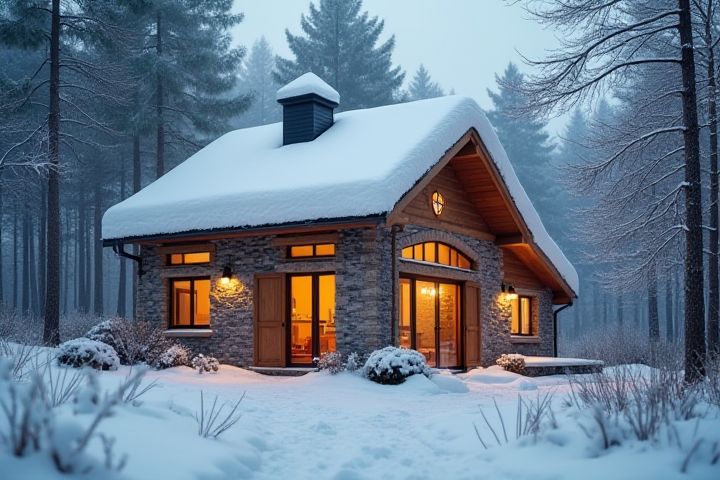
Insulation plays a crucial role in maintaining a warm house during winter by minimizing heat loss through walls, roofs, and floors. Quality windows, particularly double or triple glazed options, significantly reduce cold drafts and enhance energy efficiency. A well-functioning heating system, such as forced air, radiators, or underfloor heating, distributes warmth effectively throughout your living spaces. Sealing gaps and using weatherstripping around doors and windows help prevent cold air from entering and keep your indoor environment cozy. Properly placed textiles like thick curtains and area rugs can also serve as additional barriers against chill, allowing you to enjoy a comfortable winter home.
What Keeps House Warm In Winter
Proper insulation
Proper insulation is crucial for maintaining warmth in your home during winter months. Insulation materials such as fiberglass, foam boards, and cellulose can reduce heat loss by up to 30%, significantly lowering your heating costs. Ensure that areas like attics, walls, and basements are adequately insulated to prevent cold drafts and heat escape. For optimal performance, check for gaps or leaks in windows and doors, sealing with weatherstripping or caulk to maintain a cozy indoor environment.
Energy-efficient windows
Energy-efficient windows are a pivotal element in maintaining warmth in your home during winter months. These windows typically feature multiple panes, such as dual or triple glazing, which significantly reduce heat loss by enhancing insulation. Low-emissivity (Low-E) coatings reflect infrared light, ensuring that the heat generated inside your home stays trapped while minimizing outside cold influences. Investing in energy-efficient windows can lower your heating bills by up to 15%, creating a cozier environment while promoting sustainability.
Weatherstripping
Weatherstripping is an essential component for maintaining a warm home during winter by sealing gaps around doors and windows, which can significantly reduce heat loss. By applying weatherstripping materials, such as adhesive-backed foam, V-seal, or door sweeps, you create a barrier against cold drafts that infiltrate your living spaces. Proper installation and maintenance of weatherstripping can enhance energy efficiency, lower heating bills, and improve indoor comfort. Ensuring that your weatherstripping is intact and replacing damaged sections can make a considerable difference in your home's overall warmth during the colder months.
Sealed doors
Sealed doors are essential for maintaining warmth in your home during winter by preventing cold air from infiltrating. Gaps and cracks around doors can lead to significant heat loss, making it crucial to invest in weather stripping or door sweeps for an airtight seal. Ensuring your doors are properly insulated can result in energy efficiency, reducing heating costs and minimizing drafts. For optimal results, regularly inspect and maintain door seals to ensure your living space remains cozy throughout the colder months.
Insulated attic
An insulated attic plays a crucial role in maintaining warmth within your home during winter months. Proper insulation prevents heat loss, ensuring that the warmth generated by your heating system remains trapped within the living spaces. Materials such as fiberglass, cellulose, or spray foam are effective choices for attic insulation, reducing energy costs while enhancing comfort. Regularly checking for gaps or wear in your insulation can help you optimize its effectiveness, ensuring your home stays cozy and energy-efficient throughout the colder season.
Programmable thermostat
A programmable thermostat maintains your home's warmth during winter by allowing you to set specific temperature schedules tailored to your daily routine. By automatically adjusting the heating system based on your preferences, it ensures efficient energy use and minimizes unnecessary heating when you're not home. Many modern units feature smart technology that can learn your habits, optimizing comfort while reducing utility bills. With remote access via smartphone apps, you can conveniently control settings, ensuring your house is cozy upon your return.
Radiant floor heating
Radiant floor heating is an efficient method for keeping your home warm during winter months, utilizing a system of heated water or electric coils embedded beneath the flooring. This type of heating provides even warmth, reducing cold spots and maintaining a consistent temperature, often in the range of 70-75degF, depending on personal comfort levels. By transferring heat directly to the floor surface, radiant heating can lower energy consumption by up to 30% compared to traditional heating systems. With radiant floor heating, you can enjoy a cozy and comfortable home environment while potentially lowering your energy bills.
Thermal curtains
Thermal curtains are designed with insulating materials that significantly reduce heat loss in your home during winter months. By utilizing multi-layered fabrics and specialized coatings, these curtains can lower heat transfer by up to 25%, ensuring your living space remains cozy and energy-efficient. When drawn properly, thermal curtains create a barrier against cold air, preventing drafts and maintaining a consistent indoor temperature. Investing in quality thermal curtains not only enhances your comfort but can also lower heating costs by minimizing reliance on central heating systems.
Fireplace efficiency
A fireplace can significantly enhance your home's warmth during winter by providing both radiant heat and a cozy ambiance. To maximize efficiency, ensuring proper fireplace maintenance, such as regular cleaning and checking for blockages, is crucial; this allows for optimal airflow and heating performance. Using seasoned hardwood instead of softwoods can also contribute to longer burn times and reduced creosote buildup, increasing overall efficiency. Installing a fireplace insert can further improve heat distribution and reduce heat loss, keeping your living space warm and inviting throughout the cold months.
Regular HVAC maintenance
Regular HVAC maintenance plays a crucial role in keeping your house warm during the winter months. By scheduling routine inspections, you ensure that your heating system is operating efficiently, preventing unexpected breakdowns and prolonging the lifespan of your equipment. Cleaning or replacing air filters can improve airflow, allowing warm air to circulate effectively throughout your home. Moreover, checking ductwork for leaks and ensuring proper insulation can significantly enhance your system's performance, helping to maintain a consistent and comfortable temperature inside.
